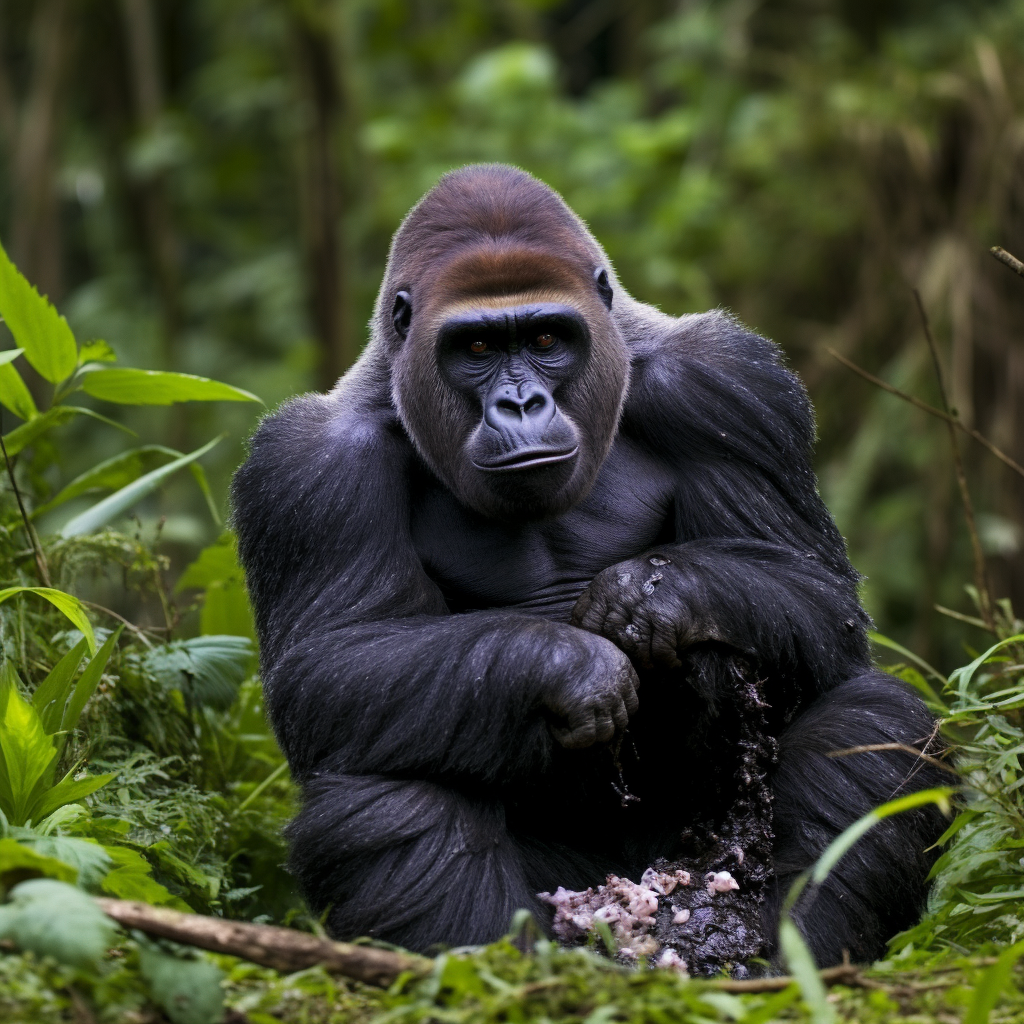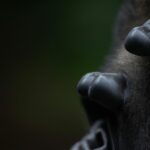
To gain a better understanding of gorillas and their fur, delve into the introduction where a brief overview of these majestic creatures awaits. Discover why gorillas have fur and explore the sub-sections that shed light on their unique characteristics and intriguing fur adaptations.
Key Takeaways
1. Gorillas have fur primarily for protection against the elements and to regulate their body temperature. The dense fur helps to keep them warm in colder climates and provides insulation during cooler nights.
2. The fur also serves as a form of camouflage, helping gorillas blend into their natural surroundings and making it easier for them to hide from potential predators.
3. Gorilla fur is unique to each individual and can vary in color and texture. This individual variation helps gorillas recognize each other and maintain social bonds within their groups.
4. The fur on a gorilla’s back is typically longer and coarser than the fur on other parts of their body. This longer fur helps to protect their skin from scratches and injuries when moving through dense vegetation.
5. Gorillas have adapted to their environment over time, and their fur is a key adaptation that has helped them survive and thrive in their natural habitats.
6. Understanding why gorillas have fur can provide valuable insights into their behavior, social structure, and overall well-being. It also highlights the importance of conservation efforts to protect these magnificent creatures and their habitats.
Brief overview of gorillas
Gorillas are captivating creatures! They are part of the great ape family, like chimpanzees, bonobos, and orangutans. Gorillas live in the forests of central Africa, and come in two species – Eastern and Western.
Their bodies are muscular, covered in thick fur to protect them from the elements. They have wide chests and strong arms. They use these arms to climb trees and show off their strength. Despite their intimidating looks, gorillas are peaceful animals. They live in family groups, led by a dominant silverback male. The females take care of the young and make sure everyone is happy.
Gorillas have smarts and unique behaviors. They eat mostly leaves, shoots, fruits, bark, and stems. They rely on plants like bamboo for water. Move over fashionistas, gorillas are about to give us hair-raising style goals with their fur game!
Importance of fur for gorillas

To understand the importance of fur for gorillas, delve into how it helps them maintain insulation from temperature fluctuations and provides protection from the elements.
Insulation from temperature fluctuations
Gorillas rely on their fur for insulation. It’s thick and dense, acting like a natural barrier against extreme heat or cold. Here are five points about the importance of fur:
- Fur traps air close to the body, protecting against temperature changes.
- Long guard hairs repel water, keeping gorillas dry and warm.
- They can adjust the fur’s thickness according to weather.
- Dark-colored fur absorbs heat, while light-colored patches reflect sunlight.
- Fur also guards against thorns, branches and insects.
Uniquely, gorilla fur has a coarse texture. The hairs overlap to retain heat in cold weather. The mountain gorillas of Virunga Massif are able to survive sub-zero temperatures due to their thick fur.
In conclusion, fur is vital for gorillas to keep a stable body temperature. Plus, it’s nature’s way of saying: no matter how you look, you’ll always be protected!
Protection from the elements
Gorilla fur serves multiple purposes. It keeps them warm in cold climates and cool in hot ones. It has natural oils that repel water, so they stay dry even during heavy rain.
The long hair on their backs protects them from scratches, abrasions and mild injuries. Plus, it’s a form of communication! They make their fur look bigger to show aggression.
Gorilla fur is also important for social interaction. Males beat their chests and vocalize loudly, flaunting their physical presence with their majestic fur.
Research conducted by scientists in Uganda’s Bwindi Impenetrable National Park found the density of gorilla fur helps protect against insect bites and sunburns. So, gorillas are environmentally conscious trendsetters!
Functions of gorilla fur
To understand the functions of gorilla fur, delve into the benefits it provides. Explore the sub-sections to unveil the solutions. The first sub-section focuses on how gorilla fur serves as camouflage for survival. The second sub-section highlights the role of fur in social signaling within gorilla groups.
Camouflage for survival
Gorilla fur has many uses, one of which is to provide camouflage. This adaptation helps them blend into their surroundings, making it harder for predators or threats to spot them. Their coarse fur texture mimics the shadows and patterns found in the forest, while their black color helps them merge with tree shadows and foliage. Also, some gorilla species have varying shades of brown fur to disappear among fallen leaves.
Plus, gorillas develop a patch of silver hair as they age that contrasts with the black coat. This adds to their appearance and can make camouflaging even easier.
An interesting story about a group of scientists observing gorillas in Central Africa is worth mentioning. They were astonished by how well the animals blended into the landscape. This further demonstrated the effectiveness of gorilla camouflage for survival.
Gorilla fur provides many functions, but its camouflage capabilities are one of the most impressive adaptations of nature. Through this, gorillas stay safe in the wild and preserve their place in the delicate balance of life. Who needs social media when you can just watch gorilla groups and their fur fashion show?
Social signaling within gorilla groups
Gorillas employ social signaling for communication in their groups. With body postures, facial expressions, vocalizations, and gestures, they convey messages, build hierarchies, and resolve conflicts. Let’s look at the types of signals they use!
Visual: Gorillas use their fur coats and body postures to show dominance or submission.
Vocal: Grunts, roars, and barks are uttered to express emotions and warn of danger.
Gestural: Chest-beating, arm-slapping, and head-nodding are used to emphasize particular messages.
Each individual may have unique variations in their communication. Observe these carefully to gain a deeper understanding of the group’s dynamics.
Gorillas’ social signaling confirms the complexity of their communication. Scientists can use this to gain insights into their societies.
Adaptations of gorilla fur

To better understand the adaptations of gorilla fur, explore how it varies in thickness and density, as well as coloration and patterns. These sub-sections offer insights into the unique solutions that gorilla fur provides for their survival and well-being.
Thickness and density of fur
Gorilla fur isn’t just a shield against the elements, but it also has important social roles. Let’s explore the thickness and density of gorilla fur.
The table below shows the differences between gorilla fur attributes:
| Category | Thickness | Density |
|---|---|---|
| Adult Males: | 1.5 – 2 cm | High |
| Adult Females: | 1 – 1.5 cm | Moderate |
| Infants: | <1 cm | Low |
Gorilla fur variation has many implications. For instance, adult males have thicker and denser fur, which helps them rule the family group.
Take Baraka, for example. He was a silverback with incredibly thick and dense fur, which made him a strong leader. His fur acted as a shield and a symbol of his authority.
Gorilla fur thickness and density offer insight into their biology and society. But that’s not all – gorilla fur also comes in unique colors and patterns! If you think fashion trends are wild, check out the gorillas’ style. Black is definitely the new black!
Coloration and patterns
Gorillas have dark black fur which helps to blend into the shadows of their dense forest habitats. This provides camouflage and helps protect them from potential threats.
Silverbacks, the dominant males, feature a distinctive silver-gray saddle-shaped patch on their backs. This is a sign of strength and maturity.
Infants have a lighter fur color. Their grayish-brown color helps them remain inconspicuous in the vegetation and also signals their reliance on other group members for protection.
The intricate patterns of gorilla fur also have an effect on their adaptation. These patterns differ between each gorilla and are thought to help with recognition within their social groups. Each pattern is a visual identifier that allows gorillas to recognize one another and stay close.
Recognizing the coloration and patterns of gorilla fur is essential when studying these amazing creatures. It helps us to better understand their behavior and support conservation initiatives to protect them. Don’t miss out on this valuable knowledge!
Evolutionary reasons for gorilla fur
To understand evolutionary reasons for gorilla fur, delve into the sub-sections: Early ancestors and fur development, Selection pressures for fur retention. Explore how these factors have shaped the presence and characteristics of fur in gorillas, illuminating their fascinating evolutionary journey.
Early ancestors and fur development
Early ancestors were key in the growth of fur for gorillas. They needed warmth and protection, so they developed thick, insulating fur coats to survive cold climates and hide in their habitats.
As time passed, their fur became thicker and was better at keeping heat. This let them live in colder temperatures and explore new places. Natural selection favored animals with dense fur, since they were more capable of withstanding harsh environments.
Fur not only kept them warm but also let them blend in their surroundings, staying hidden from predators and prey. This gave them an upper hand when hunting or running away.
Fur was also vital for social interactions. Showing vibrant colors or patterns could indicate status or reproductive fitness in the group. This makes it clear how important fur was for gorilla evolution.
Pro Tip: Knowing the evolutionary significance of gorilla fur can help us understand why it is so essential for their survival and relationships. Who needs waxing when you’ve got evolution to keep your fur intact?
Selection pressures for fur retention

Gorilla fur has many evolutionary benefits. Let’s explore why this amazing creature has fur.
- Insulation: It’s an exceptional tool to retain body heat in chilly habitats. The fur provides warmth and protects against potential health complications.
- Camouflage: It helps gorillas blend with their environment. This enhances their ability to hunt and to escape predators.
- Social Signaling: Gorillas use non-visual cues like vocalizations and physical displays instead of relying on fur. Thus, fur plays a limited role in social communication.
- Thermoregulation: Fur helps regulate body temperature. It maintains optimum levels and contributes to gorillas’ well-being.
We should protect gorilla populations and raise awareness about the importance of preserving their habitats. This way, we can ensure sustainable coexistence between humans and wildlife.
Gorilla fur: nature’s way of looking fierce!
Relationship between gorilla fur and habitat
To understand the relationship between gorilla fur and habitat, explore the differences in fur characteristics across gorilla species and examine how their fur adapts to specific habitats. Differences in fur and specific adaptations are the key aspects to consider in the understanding of this dynamic relationship.
Differences in fur characteristics across gorilla species
Gorillas, closely related to humans, have amazing fur variations based on where they live. Let’s explore the diverse fur features of different gorilla species.
Take a look at this table to see the different fur attributes:
| Species | Body Fur Color | Hair Length | Hair Density |
|---|---|---|---|
| Mountain Gorilla | Black | Long | Dense |
| Eastern Lowland Gorilla | Black | Short | Sparse |
| Western Lowland Gorilla | Brownish-gray | Medium | Moderate |
| Cross River Gorilla | Dark brown | Long | Thick |
Also, gorillas differ in body size and extra hair. These details are key for them to fit into their habitats.
Pro Tip: Studying gorillas’ fur helps us understand their evolution, but there are other factors like diet and social behavior which influence their survival.
Gorillas are fashion masters of the animal kingdom, as they know how to camouflage in any habitat!
Fur adaptations to specific habitats
Gorillas have fur adaptations that help them live in different habitats. It protects them from the elements, and provides camouflage too. Let’s look at some key points.
- In rainforests, dense fur repels water. So, even during heavy rain, they stay relatively dry.
- For gorillas in high-altitude mountains, thicker and longer fur insulates them from the cold.
- In open grasslands, brownish hair helps them blend into the vegetation. This makes it hard for predators to spot them.
Fur also helps gorillas communicate within their groups. Patterns and coloration make it easier for them to recognize each other. It’s clear that fur helps them survive, and adds to the dynamics of their societies.
Gorilla fur is amazing. It perfectly adapts to different habitats. From repelling rain, to providing warmth and camouflage – it’s a masterpiece.
It’s impossible not to feel a sense of wonder. An adventure to witness the beauty of these creatures and understand their habitat adaptations – unforgettable! So, let’s celebrate the partnership between gorilla fur and habitat – just like Beyoncé and Jay-Z!
Frequently Asked Questions
FAQ 1: Why do gorillas have fur?
Gorillas have fur to protect them from various weather conditions. The fur acts as insulation, helping them stay warm during cold weather and protecting them from the sun’s rays during hot weather.
FAQ 2: Does the fur serve any other purpose?
Yes, gorilla fur also helps them blend in with their natural environment. The coloration and texture of their fur provides camouflage, making it easier for them to hide from predators or prey.
FAQ 3: How does the fur of gorillas differ from other primates?
Gorillas have longer and thicker fur compared to many other primates. This is because they inhabit areas with colder climates and their fur provides better insulation. It also helps them withstand minor injuries or scratches.
FAQ 4: Can gorillas survive without their fur?
Gorillas are adapted to their environments and their fur plays a crucial role in their survival. Without their fur, they would be more susceptible to temperature extremes, sunburn, and potential injuries. Therefore, it would be challenging for them to survive without fur.
FAQ 5: How do gorillas maintain their fur?
Gorillas maintain their fur through regular grooming. They use their fingers to clean and remove debris from their fur. Grooming also helps strengthen social bonds among gorillas by promoting bonding and establishing hierarchies.
FAQ 6: Does the fur of gorillas change as they age?
Yes, the fur of gorillas changes with age. Infants have fine, silky hair which eventually becomes thicker, longer, and darker as they grow older. The silverback males, the dominant leaders, tend to have the thickest and longest fur.
Conclusion
Scientists have explored why gorillas have fur. It protects them from the elements and helps them blend in, plus regulates their body temperature. This adaptation is essential for survival, and also helps them communicate. Its thickness varies depending on climate. In colder areas, it’s thicker. Dr. Jane Goodall discovered that grooming is essential for healthy fur, and strengthens social bonds. Every strand has a purpose, highlighting the balance between nature and survival.
References:




